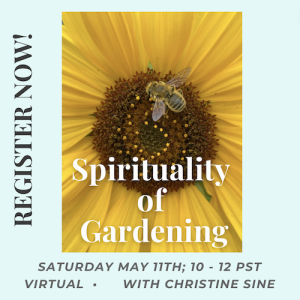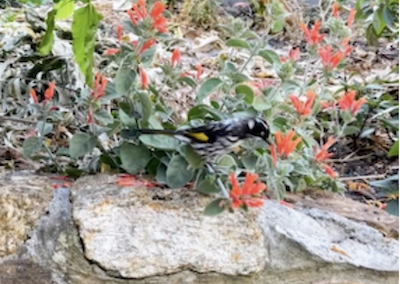by Rodney Marsh
A garden is not complete without birds. Birds that live in the garden and birds that visit. Birds bring poise, beauty and song to a garden. The photo shows a honey eater who visited my quiet prayer spot. She came to feed on some nectar from the tubular red flowers. This bird is a New Holland Honey Eater. These small active yellow, black and white birds have built nests and raised their young and made their home in this garden. These birds, will stop and be still for no man. They are always on the move. They are nectar feeding birds aid pollination and eat insects to help control garden pests.
Like some place names in Western Australia, the New Holland Honey Eater (NH honey eater) references that it was the Dutch who, in the early 17th C, were the first known Europeans to visit and name the new found land, ‘New Holland’ (Nieuw-Holland). The Western coast of Australia at the latitudes they visited is barren and forbidding. And dangerous. Many vessels, on their way to the Spice Islands (Indonesia), were wrecked on the numerous reefs and shoals. So the English name for this little bird carries a weight of history. Like the small island off Perth, ‘Rottnest’ (= “Rats’ Nest” in Dutch), referencing the local friendly quokkas (hence ‘rats’, but they are marsupials). More recently Quokkas have become famous as ’the world’s happiest animal’ via Roger Federer’s Instagram selfies.
The NH honey eaters are noisy birds. For their size, their “cheep” is very loud and oft repeated. Most often they are seen feeding as single birds, but on several occasions I have observed flocking behaviour. I happened upon a matted, dense shrub full of noise and chaos. It seems NH honey eaters enjoy an occasional jamboree. The small bush was filled with organised pandemonium. Every little bird was participating in the corroboree: jumping between twigs, flying between the branches, careering through the bush, and all managing (I do not know how) to avoid colliding with their neighbours or branches. And the noise! Every bird was cheeping. It made me think I was at Woodstock! What a joyous riot!
On another occasion a NH honey eater taught me a valuable lesson. I was seated on our verandah and heard an educational conversation between a nestling NH honey eater and its mother. I was unaware that there was a NH honey eater nest in the dense shrub nearby so the call-response dialogue was surprising. I recorded it on my phone. The parent gave four or five “cheep”s and the nestling responded with it’s own primitive version of what the parent had sounded. And so on, for about five minutes and each time the baby bird did her best to imitate her mother. The mother was patiently teaching her baby how to play her part in the world as a NH honey eater. I cannot speak ‘bird’ but I learned from the conversation that only a New Holland Honey Eater can teach a baby NH honey eater how to be a New Holland honey eater and I thought, “Only human attention can teach a baby human how to be human”.
Busy Bird Stops
Busy bird never stops
Flit and zip
Zoom and dart
Now here… there… somewhere!
Busy bird never stops
Except when she takes time for her baby
‘chirp, chirp, chirp’
‘chip, chirp, chrip’
‘chirp, chirp, chirp’
‘chip, chirp, chirp’
‘chirp, chirp, chirp’
‘chirp, chirp, chirp’
‘By Jove! I think she’s got it!’
Busy bird takes time to teach a
Baby bird how to be a bird
Do we busy humans stop.
to teach our babies to be human?
Everyday a child is calling
“Teach me to live
Teach me to be…”
Human
Give one child your total attention. Today.
Everyday a child is pleading
“Teach me to love
Teach me to be…”
Me
Give one child your total attention.Today.
Attention is love
Love is attention
Therefore to love is to attend
And learning love is practicing
to return serve …
For human babies
It is the only way
They can learn to be human
And learn to grow into
Who they are.
For your interest the the link below, Neville Collard, a Noongar man, speaks about the various types of New Holland Honey Eaters on Noongar land and their significance to Noongar people. https://whadjukwalkingtrails.org.au/media/story/new-holland-honey-eater
 On May 11 from 10 am to 12 pm PT (check my timezone) We will discuss connections between community, spirituality and gardening. Explore the wonderful ways that God and God’s story are revealed through the rhythms of planting, growing and harvesting as well as the beauty of nature. This webinar is for anyone who admires the beauty of God’s good creation, likes to walk in nature, sit by the ocean or just relax and listen to the birds in the trees. It is based on Christine Sine’s popular book, To Garden with God and each participant will receive a digital copy of this book.
On May 11 from 10 am to 12 pm PT (check my timezone) We will discuss connections between community, spirituality and gardening. Explore the wonderful ways that God and God’s story are revealed through the rhythms of planting, growing and harvesting as well as the beauty of nature. This webinar is for anyone who admires the beauty of God’s good creation, likes to walk in nature, sit by the ocean or just relax and listen to the birds in the trees. It is based on Christine Sine’s popular book, To Garden with God and each participant will receive a digital copy of this book.

